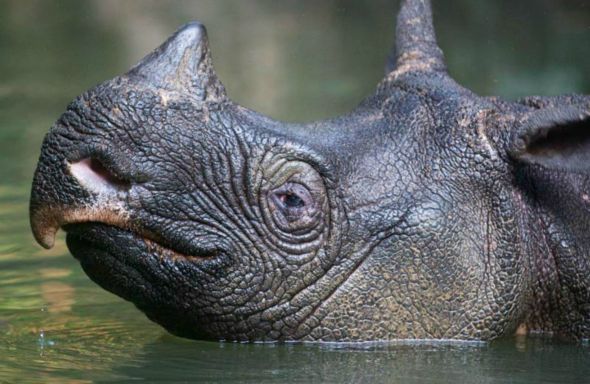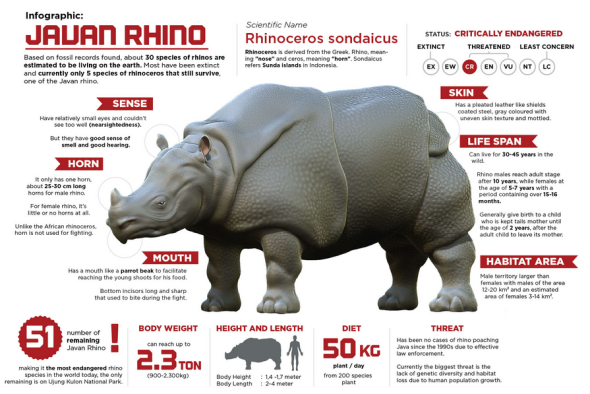Endangered Species Monday: Rhinoceros sondaicus
Endangered Species Monday: Rhinoceros sondaicus
This Endangered Species Post (ESP) Monday I have decided to touch up on the current fate of the critically endangered Javan Rhinoceros of which scientists this month caught yet another rare glimpse of this rather elusive beast within their still natural habitat. (Pic Javan Rhinoceros)
The Javan Rhinoceros was identified back in 1822 by Dr Anselme Gaëtan Desmarest (March 6, 1784 – June 4, 1838) was a French zoologist and author. He was the son of Nicolas Desmarest and father of Anselme Sébastien Léon Desmarest. Desmarest was a disciple of Georges Cuvier and Alexandre Brongniart, and in 1815, he succeeded Pierre André Latreille to the professorship of zoology at the École nationale vétérinaire d’Alfort. In 1820 he was elected to the Académie Nationale de Médecine.
Unlike the African black and white rhino, you’d be very lucky to catch a glimpse of this stunning specimen of which is classified as a sub-species of the four extant Rhinoceros and, is nearing complete extinction within the wild. Furthermore the subspecies of the Javan Rhinoceros are all extinct too. Known as Rhinoceros sondaicus sondaicus, Rhinoceros sondaicus annamiticus, and Rhinoceros sondaicus inermis the three sub-species went extinct from 1930-2011. Below I have included the “documented dates” of extinctions for the three sub-species to the Javan Rhinoceros.
- Rhinoceros sondaicus sondaicus (extinction was formally documented from 1999, however this report needs to be backed up with further historical data to pinpoint an exact extinction and location).
- Rhinoceros sondaicus annamiticus (extinction was formally recorded in 2010, however reports state the very last male was located dead within Viet Nam back in 2011).
- Rhinoceros sondaicus inermis (extinction was formally recorded back in 1925).
Please note the Wikipedia article online has confused the (extanct) R. sondaicus with the (extinct) subspecies Rhinoceros sondaicus sondaicus.
From 1965 Rhinoceros sondaicus was considered ‘extremely rare’ within the wild, then from 1986 to 1994 the species was classified as (endangered). Unfortunately from 1996 the species was again re-classified as (critically endangered) and now no fewer than sixty individuals remain within the wild. The last sighting of ‘a’ Javan rhino was I believe on the 18th September 2015 at exactly 17:46 hrs within the Ujung Kulon National Park.
Javan rhino’s did cover quite an extensive area ranging from Bangladesh, Myanmar, Thailand, Lao PDR, Cambodia, Viet Nam, and probably southern China through peninsular Malaya to Sumatra and Java. Sadly the species is now thought to be inhabiting the Ujung Kulon National Park which is located within Indonesia. Further non-viable (all male) and elderly populations are also claimed to be inhabiting a very small area of Viet Nam.
To date the species is now endemic only to Indonesia, however there are said to be few individuals ‘possibly’ remaining within Viet Nam too. I must stress though that there has been no official camera trap sightings or actual eyeball sightings of the species in as many years within Viet Nam of which its likely the species “may have gone extinct”.
Regional extinctions of the current sub-species have occurred within the following countries; Bangladesh; Cambodia; China; India; Lao People’s Democratic Republic; Malaysia (Peninsular Malaysia); Myanmar and Thailand. Reports from the 18th September 2015 have also confirmed that the species has taken some ‘fifty years’ to double in size from (50) to now (60) individuals remaining.
From the middle of the nineteenth century the species was practically eradicated due to over-hunting, unregulated hunting, poaching, disease and habitat destruction. The last records of the Javan Rhinoceros within locations not listed above were from 1920 in Myanmar, to 1932 in Malaysia, and 1959 on Sumatra (Indonesia). Up to date records have proven further sightings this year and last year within Indonesia’s Ujung Kulon National Park. The last “known” poached Javan Rhino (sub-species) was said to be from 2010-2011 which was that of the Rhinoceros sondaicus annamiticus species of which “complete extinction” was formally documented in relation to this specific sub-species of the Rhinoceros sondaicus.
The exact number of individuals noted within the wild is said to be in between 40-60 individuals however due to such small “fragmented locations” its quite difficult at times to know just how many do actually remain, hence the need for increased conservation projects, funding and anti poaching operations to increase. On a good note we know the species is reproducing, unfortunately on a bad note 40-60 individuals is considered near extinct and drastic measures need to be implemented sooner rather than later to preserve the remaining wild specimens.
The second “alleged” location and I stress alleged of the Rhinoceros sondaicus occurs in and around the Cat Loc part (Dong Nai province) of the Cat Tien National Park in Viet Nam, with maybe as few as six individuals remaining. Please do remember not to confuse the extinction of the Rhinoceros sondaicus annamiticus within the same country (Viet Nam) with the Rhinoceros sondaicus that’s considered still extant although possibly believed to be extinct within (Viet Nam). (I will be providing an update in relation to the alleged Cat Tien Javan Rhino R. sondaicus) via my main Facebook site and will correct amend this document accordingly.
Something I do find rather peculiar is that there are currently no Javan Rhinoceros within protective captivity. Records have stated that some twenty two individuals have been recorded within protective captivity though. I do find this rather strange as we have in zoological gardens around the world just about every other species of Rhinoceros to protect its current future for reintroduction back into the wild at a later date - yet the Javan Rhinoceros has literally been left to its own demise. I’ve yet to locate any real reasonable explanation as to why from the mid 1980’s some individuals were not removed from the wild and bred within protective captivity.
Image: Javan Rhinoceros information graph.
The Javan Rhinoceros currently occurs in lowland tropical rainforest areas, especially in the vicinity of water. The species formerly occurred in more open mixed forest and grassland and on high mountains. Because of its rarity, little is known about its preferred habitat, but it is certainly not naturally restricted to dense tropical forest water. Little is known about the species’ biology and the habitats in which the two remaining populations are found may not be optimal.
The home range size of females is probably no more than 500 ha, while males wonder over larger areas, with likely limited dispersal distance. The species is generally solitary, except for mating pairs and mothers with young. Its life history characteristics are not well known, with longevity estimated at about 30-40 years, gestation length of approximately 16 months (as with other rhino species), and age at sexual maturity estimated at 5-7 years for females and 10 years for males. -IUCN.
Unlike their African relatives the Javan Rhinoceros has a rather small single black horn (typical of Asiatic rhinos). The black market for rhino horns varies with species and price of current horn however it must be noted that the “rarer” the species the more value the horn will provide to the seller. Your average African Rhinoceros horn fetches in the region of $60,000 to $80,000 per kilogram on the black market. However the Asiatic Rhinoceros horn[s] can fetch over or even double this should the species be considered extremely rare.
On a recent visit to Viet Nam I was viewing more Asiatic antique Rhinoceros horn on the black market still selling at higher prices than African rhino horns, however not once did I locate any fresh African horns (2014). So again the need to drastically increase conservation actions, funding and anti poaching patrols is greatly needed. In my own opinion there seems to be way too much funding and awareness pushed into Africa with little progress being seen. Whereas in relation to the Asian Rhinoceros, funding and awareness identical to whats being witnessed in Africa is not even a fraction seen within Asia.
Threats
The cause of population decline is mainly attributable to the excessive demand for rhino horn and other products for Chinese and allied medicine systems. The bulk of the remaining population occurs as a single population within a national park and the population size in Ujung Kulon National Park is probably limited to the effective carrying capacity of the area (around 50 animals). One possible threat to this population is disease. In addition, such a small population faces a constant threat from poachers, although there is evidence that current poaching levels are under control. The Cat Loc population may be too small to be viable, and no breeding has been observed for many years, and it is possible that the animals are too old to breed. The population is so small that all the animals could be of the same sex.
While we have in the past month witnessed new Javan sightings and evidence of reproduction the Javan Rhino is by far nowhere near from danger. As explained above disease could wipe the entire fifty to sixty remaining individuals out. Furthermore while poaching levels are currently under control - it will only take a single individual or group of poachers to gather intelligence on the remaining populations thus exterminating the entire wild populations indefinitely.
My name is Dr Jose C. Depre, thank you reading and please be most kind to share and make aware the current plight of our Asiatic Rhinoceros.
Dr Jose C. Depre
Environmental and Botanical Scientist.
NB: Please note that while there have been “reported sightings” of the R. sondaicus in Viet Nam there is no up to date data that proves this species is still endemic to the country of Viet Nam.





